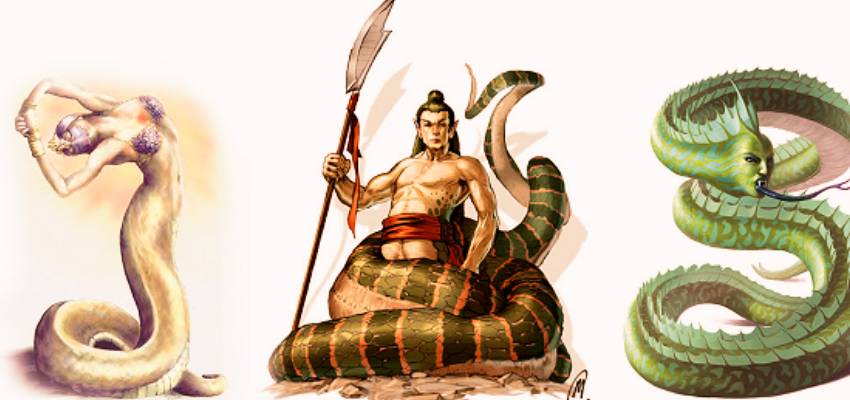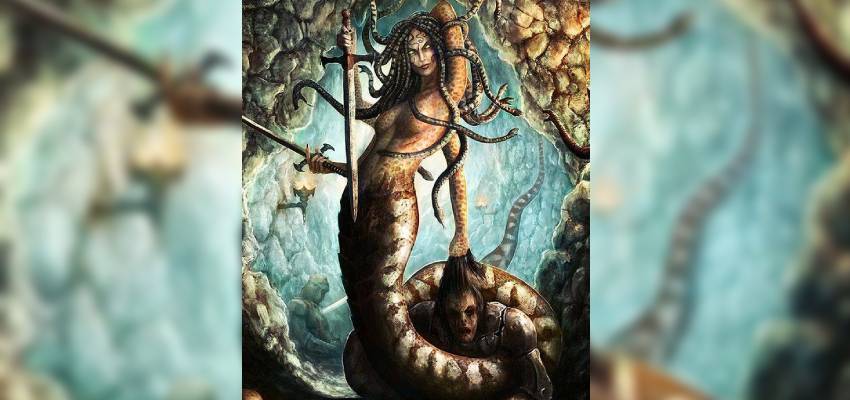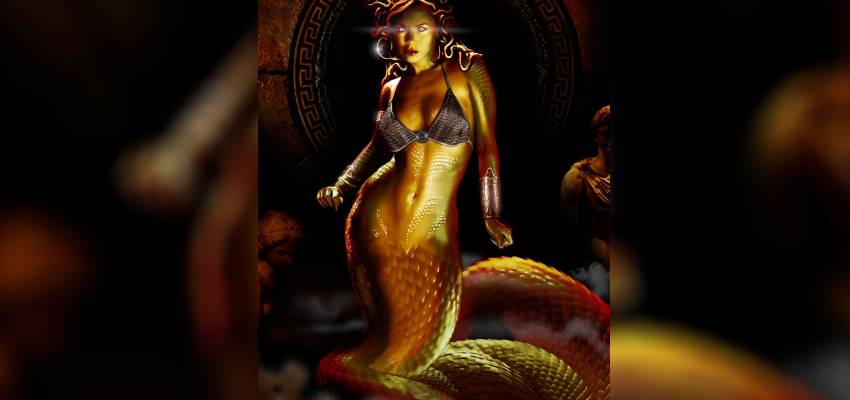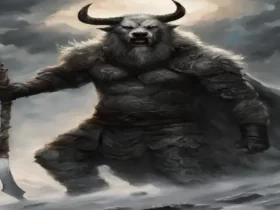Half human, half snake like creatures have long been revered in myth and legend as powerful, otherworldly beings. These legendary creatures are often depicted as having the upper body of a human and the lower body of a snake, with scales covering their skin and piercing eyes that seem to see right through you.
In many mythologies, these half human – half snake like creatures are revered as guardians and protectors, watching over their people and offering guidance and wisdom. They are also feared as deadly predators, able to strike with lightning speed and poison their enemies with a single bite.
1Echidna

Greek mythology describes the Echidna as a cave-dwelling monster that is equal parts snake and woman. Its name means “She-Viper” in Greek. She was the mother of many of the most infamous monsters from Greek mythology and the partner of the terrifying monster Typhon.
She was often associated with the corruptions of the earth, such as rot, slime, and disease. In some accounts, she was equated with Python, a dragon born from the residue left by a great flood, or was said to reside in Tartaros, a dark and swampy pit beneath the earth. Ekhidna was also described as the consort of Typhoeus, a monstrous storm-giant who sought to challenge Zeus for the throne of heaven. Together, they had many offspring, including famous monsters such as the Chimera, Cerberus, the Hydra, the Sphinx, and the Hesperian Dragon.
Half fearsome snake, half lovely maiden, Hesiod’s Echidna was a hybrid creature. The fierce goddess Echidna was described by Hesiod as a flesh-eating “monster, irresistible,” who was neither like “mortal men” nor “the undying gods,”
2Naga

The Naga are a group of serpentine creatures that appear in Indian mythology and literature. The word “naga” means “snake” or “serpent” in Sanskrit. According to the Mahabharata, an ancient Indian epic, the Naga were a group of people who worshipped serpents and were eventually described as being serpentine themselves. In many depictions, the Naga have the bodies of giant serpents and the upper torsos of humans, although there are also versions that have no arms and only a human head in place of the snake’s head. In some legends, the Naga are said to be able to communicate with all types of serpents and may even have their own human-like settlements. In a fantasy setting, the abilities of the Naga may be expanded to include the ability to communicate with other serpentine monsters, such as giant sea serpents or the Oroborous, a mythical creature that is said to circle the world.
3Nure Onna

Nure-onna, also known as Nure-yomejo, is a reptile that has a snake-like body and a woman’s head. Its name means “wet woman.”. Nure-onna is frequently a cross between a sea serpent and a vampire. She prowls open waters like rivers, lakes, and oceans looking for her prey, which is human beings and their blood. She can be found in Kyushu, Niigata, and Fukushima. According to rumors, nure-onna and ushi-oni collaborate frequently and may even be married to one another. Then, Nure-onna walks into the water and vanishes after giving her child to kind strangers. The infant weighs so much that the victim is immobile. Following that, Ushi-oni emerges from the water to join the attack and feed on the prey.
4Shahmaran

The name “Shahmaran” refers to a mythical creature that can be found in the Middle East and is particularly common in the cultures of eastern Turkey’s Anatolia. These cultures’ folklore describes Shahmaran as a being with the top half of a woman and the bottom half of a snake. Shahmaran supposedly possessed magical abilities that would ultimately cause her to betrayed and killed by people. The mythical creature known as Shahmaran is present in many Middle Eastern cultures, particularly those of eastern Anatolia in Turkey. These cultures’ folklore describes Shahmaran as a being with the upper half of a woman and the lower half of a snake. In accordance with legend, Shahmaran possessed magical abilities that would ultimately cause her to betrayed and killed by people.
5Nuwa And Fuxi

Fuxi and Nuwa are conjoined figures from Chinese mythology who are depicted with human upper bodies and serpentine lower bodies. According to legend, they were the only survivors of a great flood and were tasked with repopulating the world. They are often shown holding a compass and a ruler, which symbolize the traditional Chinese understanding of the universe in which the Heavens are round and the Earth is square. Behind them are the sun, moon, and various constellations, representing the microcosm of the universe. Fu Xi was believed to have the ability to transform into a dragon and was said to have encountered the first dragon in 2962 BCE. He and his sister Nuwa retreated to Kunlun Mountain and prayed for a sign from the Emperor of Heaven, who approved of their union. Fu Xi then ruled over their descendants for a long period, the length of which is disputed in different sources.
6Medusa

Medusa is a figure from Greek mythology known for her snake-like hair and her ability to turn those who looked at her to stone. She was one of three Gorgon sisters, along with Stheno and Euryale, and was the only one who was not immortal. Different sources attribute her parentage to either Gaia or the sea deities Phorcys and Ceto. It is believed that Medusa was born at sea and lived in the Western Ocean near Sarpedon or in Libya, according to different accounts. She is generally depicted as being unmarried, although some sources say she married Perseus. She is also said to have had a relationship with Poseidon, which resulted in the birth of Pegasus, the winged horse, and Chrysaor, the hero with the golden sword. Some accounts say that these offspring were born from Medusa’s severed head.
7Stheno

Stheno was one of the three Gorgon sisters in Greek mythology, known for her ferocity and independence. She is said to have killed more men than her sisters combined. In Roman mythology, Stheno was transformed into a Gorgon along with her sisters Medusa and Euryale as punishment for an act of desecration committed by Medusa. According to the story, Medusa, a priestess of the goddess Minerva, was raped by the sea god Neptune in Minerva’s temple, leading to the transformation of the Gorgon sisters. Stheno is portrayed as a slender gorgon monster with red snakes curled around her head in place of hair. She is described in earlier accounts as having bronzed hands, a snake belt around her waist, a boar’s tusk, a scaly head, a protruding tongue, and glowing eyes.
8Euryale

Euryale was one of the three Gorgons in Greek mythology, along with Stheno and Medusa. Like her sisters, she had the ability to turn anyone who looked at her to stone with her gaze. In many stories, Euryale is known for her loud, anguished cries, which were said to be powerful enough to cause the stone to crumble to sand. This is particularly evident in the story of Medusa’s death at the hands of Perseus, in which Euryale’s cries are described as being particularly loud and distressing.
9Lamia

Lamia was a queen of Libya in Greek mythology who was transformed into a child-murdering monster after suffering a great loss. According to legend, the goddess Hera killed all of Lamia’s children (except for Scylla) out of anger because Lamia had slept with her husband, Zeus. Lamia’s grief over the loss of her children caused her to become a monster who took revenge on other mothers by stealing and eating their children, similar to the demon Lilith in Near Eastern mythology. Lamia was described as being half-woman and half-serpent, with a human upper body and a serpentine lower body. She was similar to other female monsters in Greek and Roman mythology, such as the empousai and the mormolykei, but was distinguished by her serpentine lower half.
10Gonggong

Gonggong is a water god in Chinese mythology who is known for causing a catastrophic flood that caused chaos on Earth. He is sometimes referred to as Kanghui in ancient texts and is typically depicted as a large, black dragon with a human face and a horn on his head. In some accounts, he is described as having a serpentine body, a human face, and red hair. Gonggong is often depicted as a demon deity with great strength who fought with other gods to rule over the world. He is infamous for his role in a battle that broke one of the pillars that supported the heavens, which was caused by his anger and vanity. There are various versions of this story, but all of them depict Gonggong’s actions are the cause of the chaos.
Whether they are revered or feared, one thing is certain: half human, half snake like creatures are truly legendary and mythical, and their power and mystery will continue to captivate our imaginations for generations to come.





